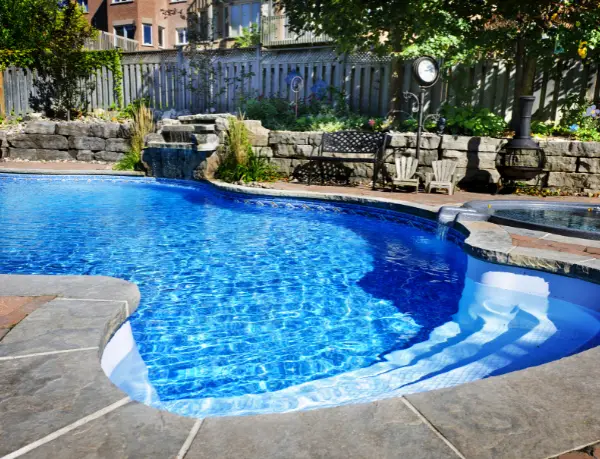
Planning a backyard pool is an exciting step, but it’s easy to get swept up in the dream without realizing the details that make or break the experience. From drainage issues to permit surprises, even small missteps during the planning phase can lead to expensive fixes and safety concerns down the line.
Many homeowners jump into pool projects without understanding the complexities involved, leading to costly repairs and safety hazards down the road. A well-maintained pool can add 7% to the home’s value, but only when it’s designed and built correctly. The key lies in understanding what not to do before you break ground.
Let’s walk through some of the most common pool design mistakes and how you can avoid them for a smooth, stress-free build.
Site Planning and Assessment Errors
Proper site evaluation forms the foundation of any successful pool project. Unfortunately, this critical step often gets rushed or overlooked entirely, leading to problems that become apparent only after construction begins.
One of the biggest mistakes homeowners make is settling for a standard design that doesn’t fully use the space or lacks modern upgrades. That’s why working with experienced professionals matters. Luxury pool builders go beyond the basics, offering smart pool systems that let you control lighting, water features, and temperature right from your smartphone.
Their color-changing LED lighting and custom automation options allow you to create the perfect ambiance for day or night. With their local expertise and cutting-edge features, your pool won’t just look beautiful, it’ll feel like a personalized retreat built to last.
Inadequate Soil and Drainage Analysis
Custom pool builders know that soil conditions can make or break a pool project. Clay soils expand and contract with moisture changes, potentially cracking your pool shell. Sandy soils might not provide adequate support for heavy concrete structures. Rocky terrain increases excavation costs dramatically and can damage equipment.
Poor drainage creates even bigger headaches. Water that doesn’t flow away from your pool area can cause flooding, foundation issues, and constant maintenance problems. Without proper analysis, you might discover your “perfect” pool location sits over an underground spring or requires expensive soil stabilization. These surprises can add thousands to your project cost and delay completion for weeks.
Utility Line Conflicts
Nothing stops a pool project faster than hitting a gas line or electrical cable during excavation. Many homeowners don’t realize how many utilities run through their property. Water lines, sewer pipes, electrical cables, and gas connections all need identification before digging begins.
Swimming pool builder professionals always call utility marking services and conduct private utility locates. They’ll also consider future utility needs, ensuring your pool design doesn’t block access for repairs or upgrades.
Smart planning prevents dangerous accidents and costly utility relocations that can derail your timeline and budget.
Space and Access Limitations
Pool contractors frequently encounter properties where the desired pool simply won’t fit properly. Homeowners often underestimate the space needed for equipment, decking, and landscaping around the pool itself.
Access for construction equipment is another common oversight. Can excavators reach your backyard? Is there room for concrete trucks to pour your deck? These logistics affect both the cost and the feasibility of your project.
Material and Construction Missteps
The materials you choose and how they’re installed determine your pool’s longevity and maintenance requirements. Cutting corners here often leads to expensive repairs later.
Inferior Material Selection
Inground swimming pools require materials that can withstand constant water exposure, temperature changes, and chemical treatments. The cheap pool finishes crack and stain quickly. Low-grade pumps and filters fail prematurely, disrupting your swimming season.
Quality materials cost more upfront but save money long-term. Premium plaster finishes resist staining and last for decades with proper care. High-efficiency equipment reduces energy costs while providing better water circulation.
Professional builders use proven materials with solid warranties. They’ll explain why certain products justify their higher cost and how they protect your investment.
Poor Equipment Placement
Pool equipment needs proper ventilation, drainage, and accessibility for maintenance. Placing pumps and filters in cramped spaces or areas prone to flooding creates ongoing problems.
Equipment should be positioned to minimize noise for both your family and neighbors. Heat pumps and pool cleaners can be surprisingly loud when poorly located.
Consider future service needs, too. Technicians need space to work safely and efficiently. Cramped equipment areas increase service costs and downtime.
Inadequate Structural Support
Pool design mistakes often involve underestimating structural requirements. Pools exert tremendous outward pressure that must be contained by properly reinforced walls. Skipping reinforcement steel or using inadequate concrete mixes can lead to catastrophic failures.
Decking and coping also need proper support. Heavy materials like natural stone require stronger foundations than basic concrete. Planning for future additions like outdoor kitchens or fire features requires additional structural considerations.
Design Integration Failures
Your pool should complement your home’s architecture and your family’s lifestyle. Poor integration creates visual discord and functional limitations that reduce enjoyment and property value.
Ignoring Architectural Harmony
Pools that clash with their surroundings look awkward and can actually decrease property values. A modern geometric pool might look out of place next to a traditional colonial home. Similarly, ornate designs with multiple water features can overwhelm simple ranch-style houses.
Consider your home’s style, existing landscaping, and outdoor living areas when planning your pool design. The goal is to create a cohesive outdoor environment that feels intentional and well-planned.
Color choices matter too. Pool finishes should complement your home’s exterior palette rather than competing with it.
Neglecting Family Lifestyle Needs
Pool design mistakes frequently stem from focusing on aesthetics while ignoring how your family actually uses outdoor spaces. A lap pool won’t work well for families with young children who need shallow play areas.
Think about privacy needs, sun exposure preferences, and entertaining patterns. Do you host large gatherings or prefer intimate family time? Your pool design should support these activities.
Consider future needs, too. Children grow up, mobility needs change, and lifestyle preferences evolve. Flexible designs accommodate these changes better than highly specialized layouts.
Poor Landscape Integration
Pools shouldn’t exist in isolation from surrounding landscaping. Plants, hardscaping, and outdoor structures should work together to create attractive, functional outdoor spaces.
However, plant selection requires careful consideration. Trees that drop leaves create maintenance nightmares. Plants with extensive root systems can damage pool shells and plumbing. Flowering plants that attract bees might not be ideal near swimming areas.
Professional landscape designers understand these relationships and can recommend plants that enhance your pool area without creating problems.
Safety and Legal Oversights
Safety regulations exist to prevent accidents and protect families. Skipping these requirements can result in fines, insurance issues, and tragic accidents.
Permit and Code Violations
Many amateur builders skip the permit process to save time and money. This creates serious problems when you try to sell your home or file insurance claims. Unpermitted work typically needs expensive corrections to meet current codes.
Building codes address important safety issues like fence heights, gate mechanisms, and electrical installations. These requirements protect your family and visitors from preventable accidents.
Working with licensed professionals ensures your project meets all local requirements and passes required inspections.
Inadequate Safety Features
Modern pools require multiple safety layers, including fences, alarms, and covers. Some homeowners view these as optional extras, but they’re essential for preventing drowning accidents.
Pool fences must meet specific height and gap requirements. Gates need self-closing and self-latching mechanisms that children can’t defeat. Pool alarms detect unexpected water entry and alert you to potential problems.
Safety covers provide protection when pools aren’t in use while reducing maintenance requirements during the off-season.
Electrical Safety Shortcuts
Pool electrical systems require specialized knowledge and components. Water and electricity create deadly combinations when improperly handled. All electrical work must meet strict codes for ground fault protection and proper grounding.
Lighting, pumps, heaters, and automation systems all need professional installation. DIY electrical work around pools is extremely dangerous and typically violates local codes.
Budget and Timeline Miscalculations
Poor financial planning leads to incomplete projects, corner-cutting, and family stress. Realistic budgeting prevents these problems and ensures your project’s successful completion.
Underestimating Total Project Costs
Pool construction involves many components beyond the basic shell. Decking, landscaping, fencing, and equipment can easily double your initial estimates. Permit fees, utility relocations, and site preparation add additional costs.
Smart homeowners budget 20-30% above initial estimates for unexpected issues. Rock excavation, utility conflicts, and weather delays commonly impact both costs and timelines.
Quality pool contractors provide detailed estimates that include all necessary components. Beware of low bids that exclude important items or use inferior materials.
Ignoring Long-Term Maintenance Costs
Pools require ongoing expenses for chemicals, utilities, equipment repairs, and professional services. Annual maintenance costs can range from $1,000 to $3,000, depending on pool size and features.
Energy-efficient equipment reduces operating costs but requires a higher upfront investment. Consider these trade-offs when making equipment selections.
Regular maintenance prevents expensive repairs and extends equipment life. Factor these costs into your ownership budget from the beginning.
| Common Pool Design Mistakes | Consequences | Prevention Strategy |
| Poor site assessment | Drainage issues, structural problems | Professional soil and utility analysis |
| Cheap materials | Frequent repairs, early replacement | Invest in quality components |
| Ignoring codes | Fines, insurance issues, safety risks | Work with licensed professionals |
| Inadequate planning | Budget overruns, timeline delays | Detailed project planning and contingency funds |
Final Thoughts on Pool Design Success
Avoiding pool design mistakes requires careful planning, professional expertise, and realistic expectations. The most expensive mistakes often stem from rushing decisions or trying to save money in the wrong places. Quality materials, proper permits, and experienced professionals might cost more initially but prevent costly problems later.
Your pool represents a significant investment in your family’s lifestyle and your property’s value. Taking time to plan properly and avoid common pitfalls ensures years of safe, enjoyable swimming. Remember, it’s much easier to do things right the first time than to fix expensive mistakes later.
What is the most expensive part of building a pool?
The most expensive part of installing a pool is typically the construction phase, which includes excavation, framing, and the installation of the pool shell. The construction phase encompasses a range of costs, from labor to materials.
How can I avoid drainage problems with my pool?
Proper site grading and drainage planning prevent water accumulation around your pool. A professional site assessment identifies potential issues before construction begins, allowing for corrective measures.
Do I need permits for my pool project?
Yes, permits ensure your pool meets safety codes and legal requirements. Unpermitted pools can create insurance issues, resale problems, and safety hazards that cost more to fix later.


